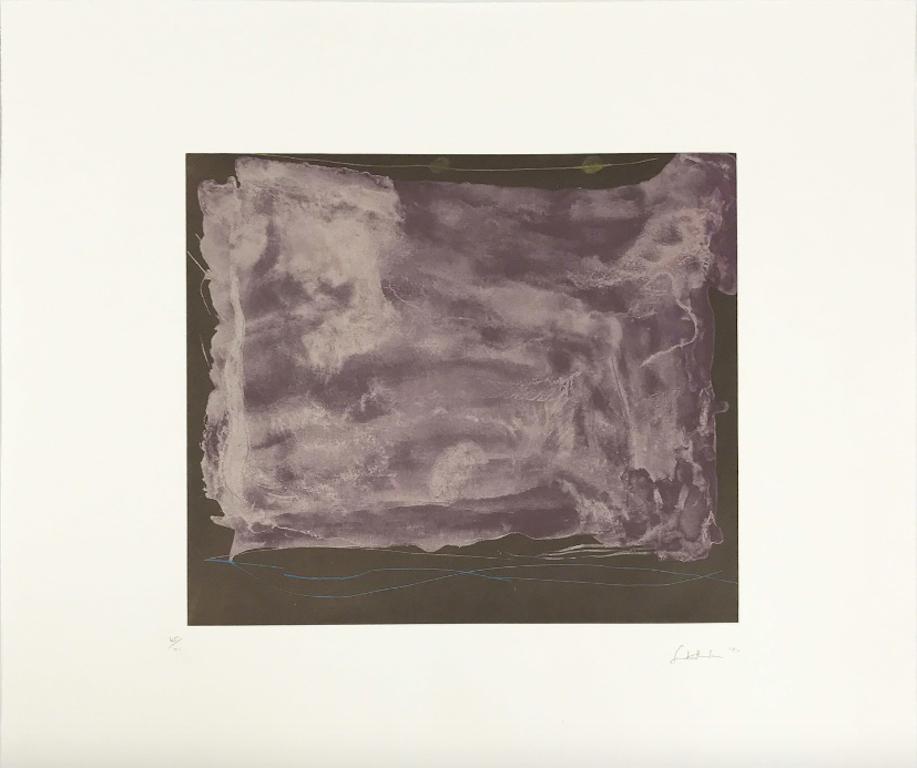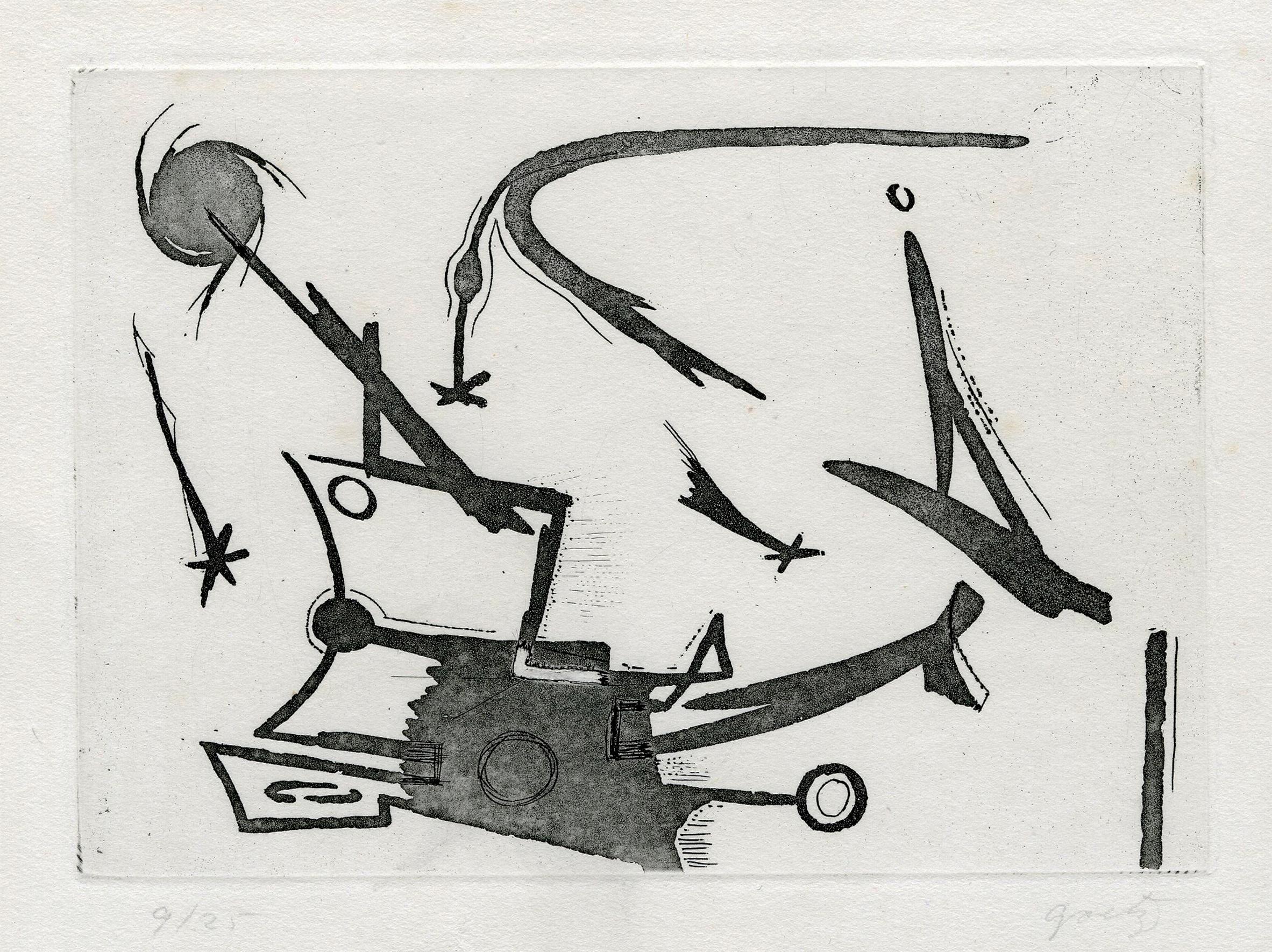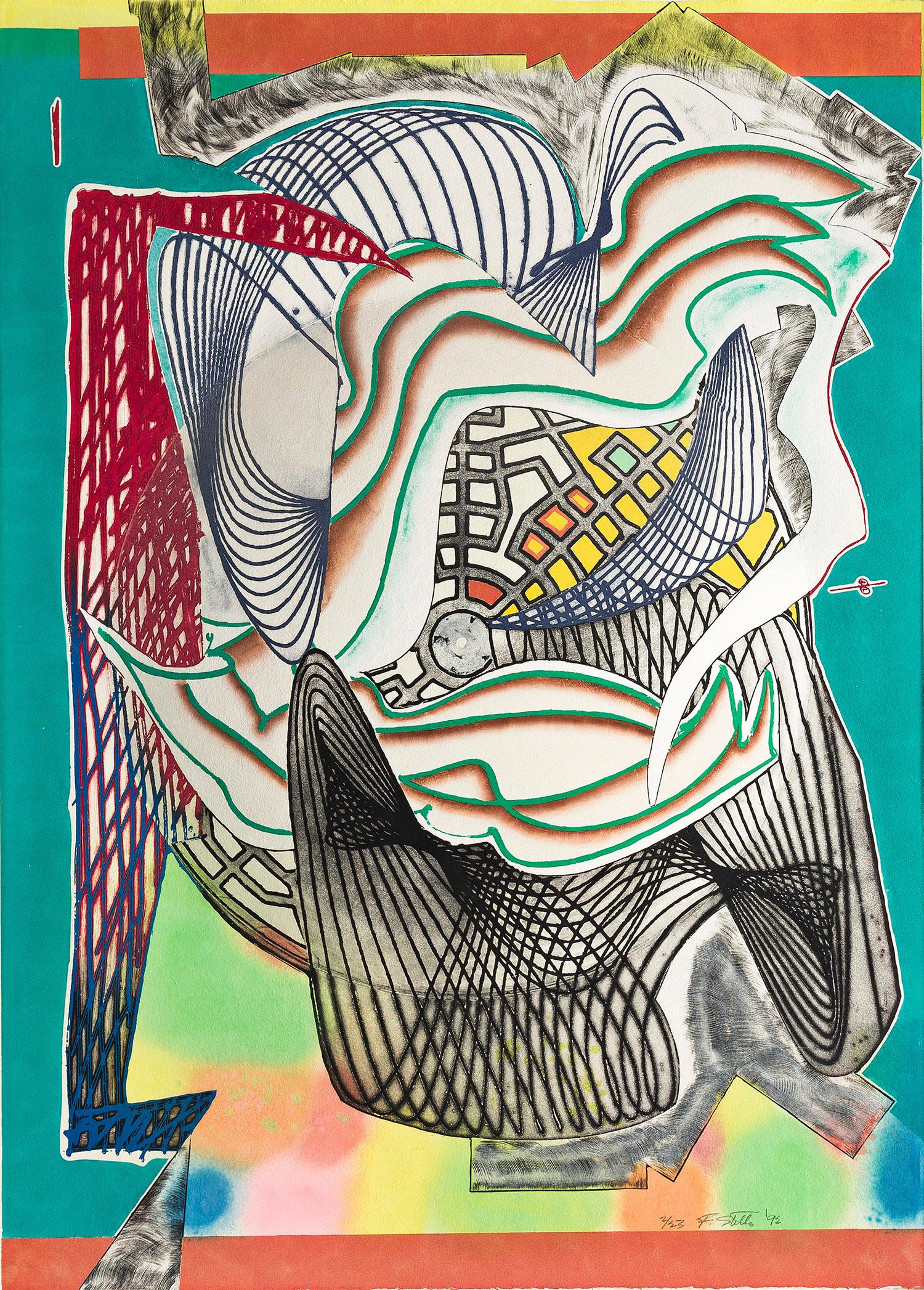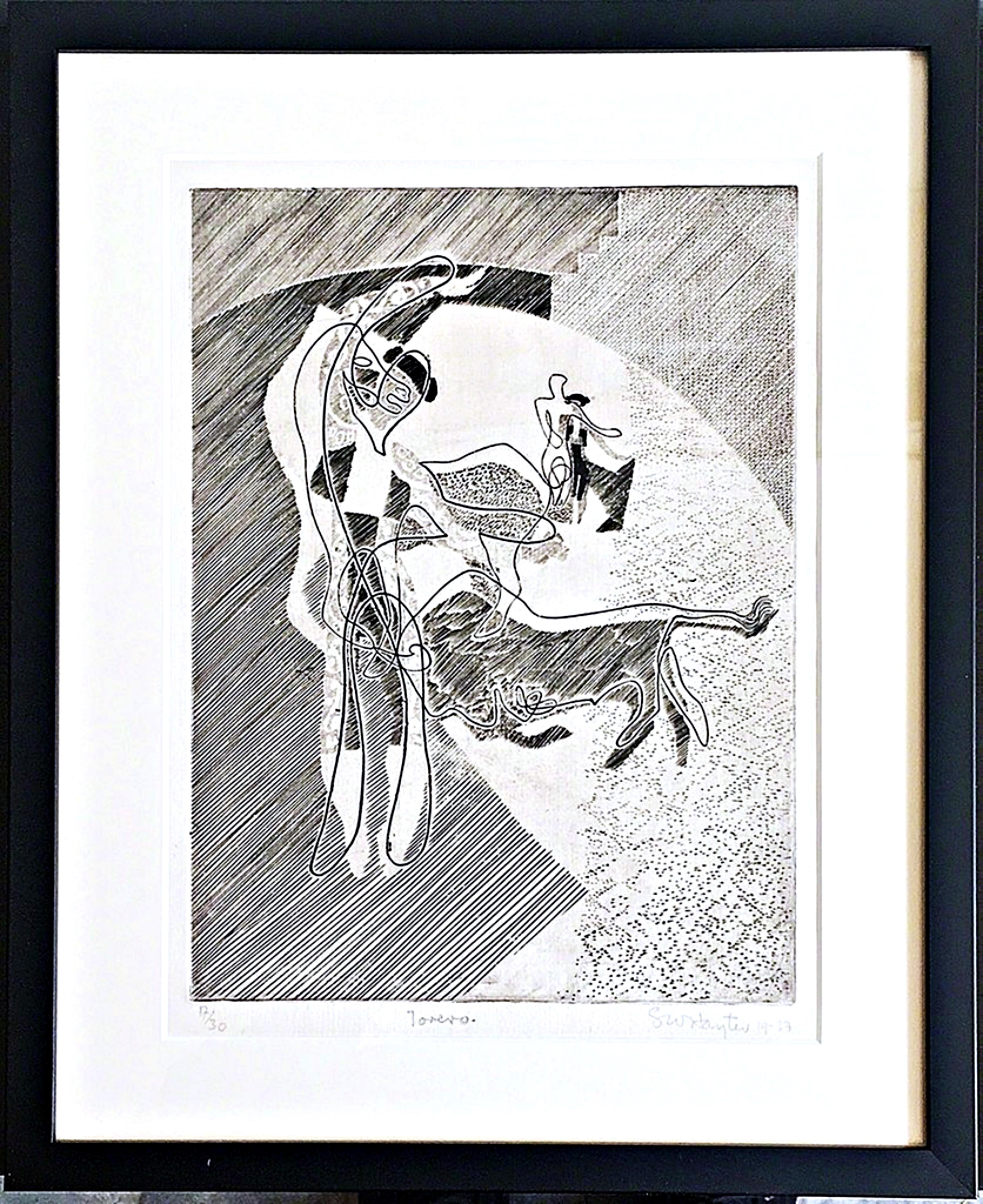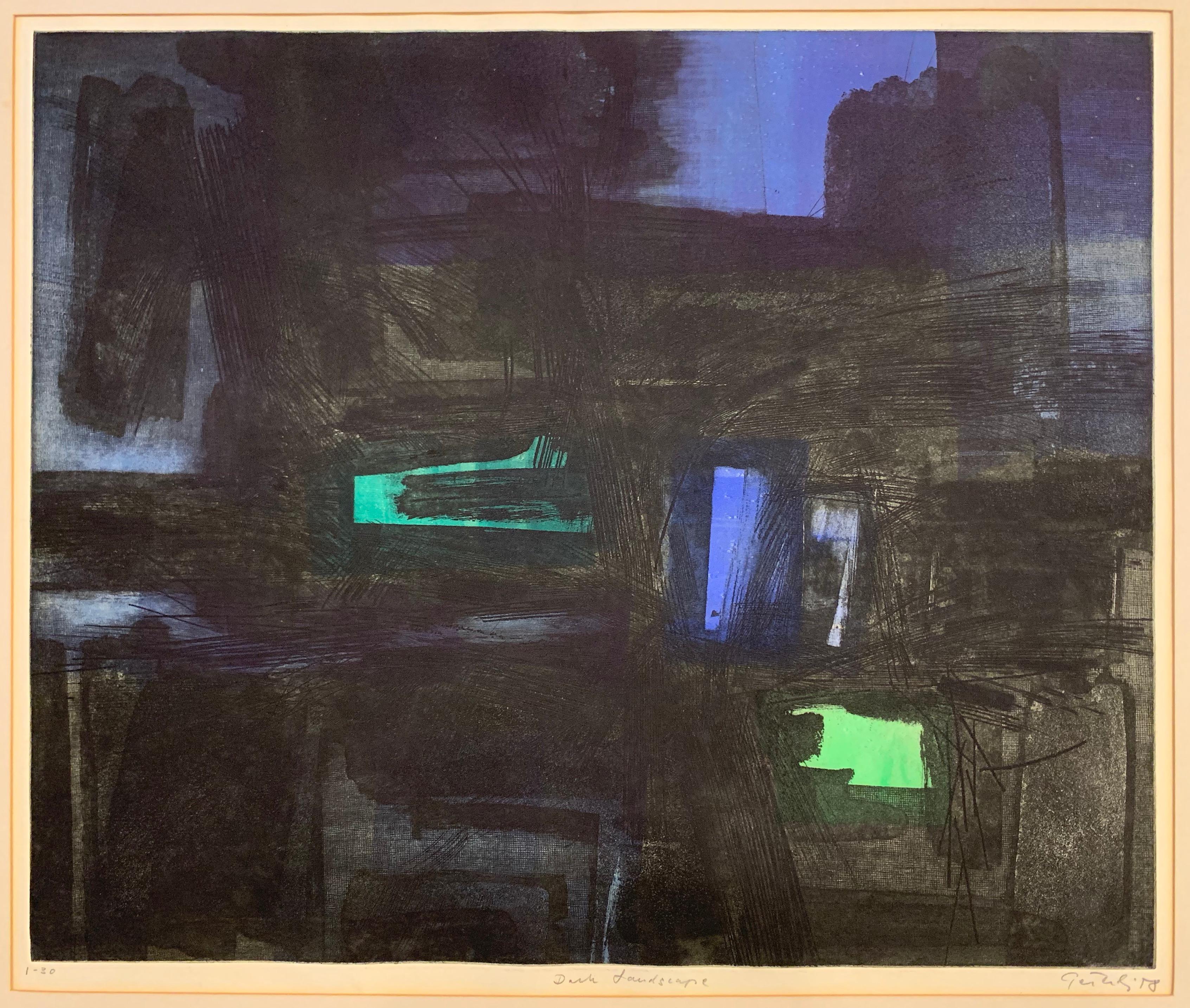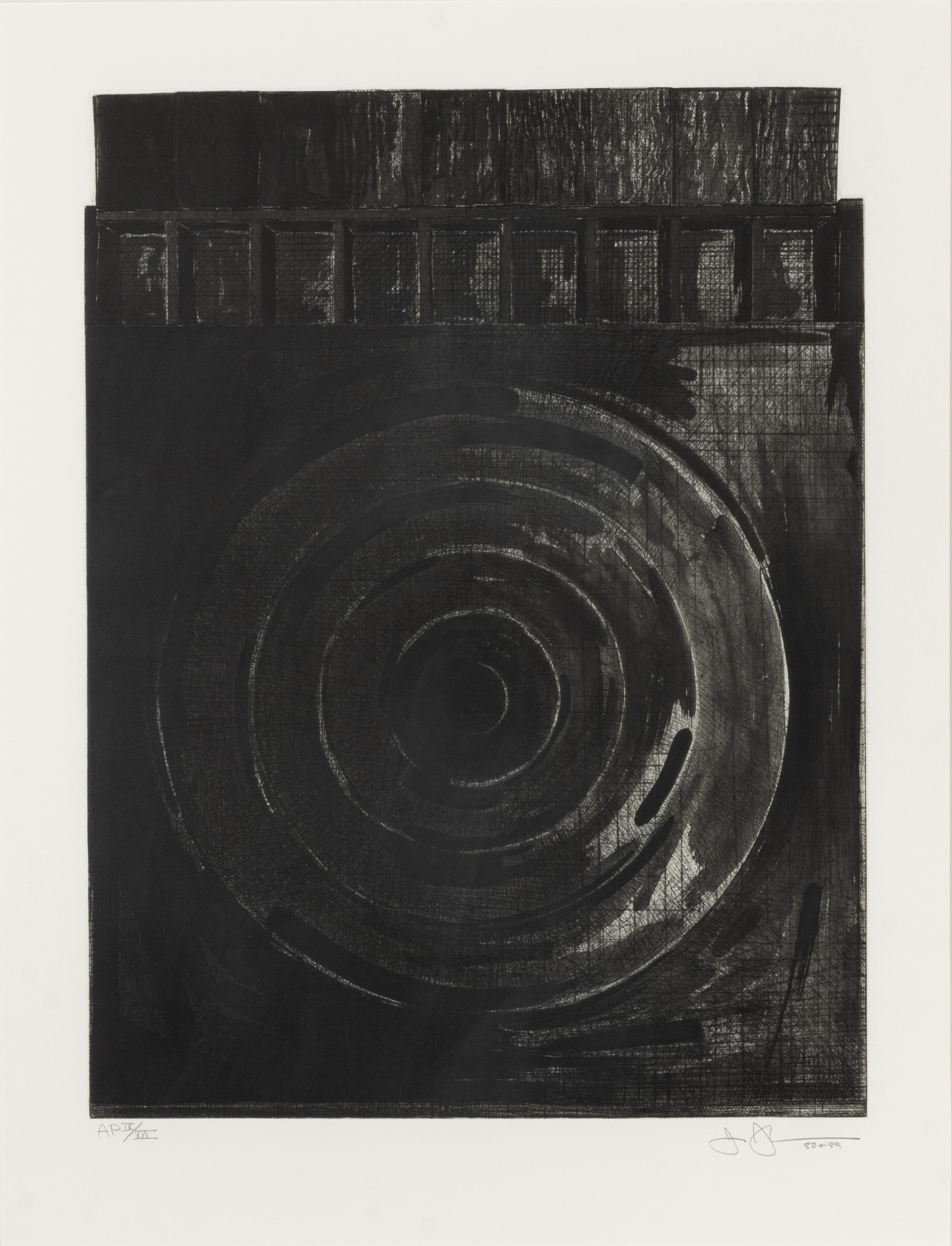Items Similar to 'Feu sous L'eau' (Fire Under Water) —Mid-century Modernism, Atelier 17
Want more images or videos?
Request additional images or videos from the seller
1 of 3
Stanley William Hayter'Feu sous L'eau' (Fire Under Water) —Mid-century Modernism, Atelier 171955
1955
About the Item
Stanley William Hayter, 'Feu sous L'eau (Fire Under Water)', color engraving, soft-ground etching and scorper with yellow silkscreen, 1955, edition 50 plus 10 artist proofs, Black & Moorhead 221. Signed, titled 'Fire Under Water', dated and annotated 'Essai' in pencil. Dedicated in the artist’s hand 'for Adja & Dove WH Bill 17–5–55' in the top margin. A superb, richly inked impression with fresh colors, on heavy, cream wove paper; wide margins (2 1/2 to 3 7/8 inches), in excellent condition. One of 10 artist’s proofs. Image size 10 3/16 x 7 inches; sheet size 18 1/8 x 12 1/4 inches. Matted to museum standards, unframed.
ABOUT THIS WORK
In 1950 Hayter returned to Paris and reopened Atelier 17. Works such as 'Fire Under Water' reveal newfound influences, such as that of the Ardèche area of southern France, where he acquired a house in 1951 and frequently visited. Hayter took great interest in the flowing Escoutay River, an experience that parallels the artist and co-director of Atelier 17 Krishna Reddy’s interest in depicting water. While some forms in this print evoke the natural world, the palette of contrasting tones of purple, yellow, black, and white reflects Hayter’s belief in using color intuitively to express emotions and evoke feelings. The sharp white relief lines from the paper and the textural effects realized through soft-ground etching operate in tandem with the sweeping curves and bold colors to give the composition a sense of vitality and dynamism.
—edited from the Metropolitan Museum of Art
Published by 'La Jeune Gravure Contemporaine', Paris.
Impressions of this work are in the following collections: British Museum, Metropolitan Museum of Art, National Gallery of Art.
ABOUT THE ARTIST
Stanley William Hayter (1901-1988) was a British painter and printmaker associated in the 1930s with Surrealism and from 1940 onward with Abstract Expressionism. Regarded as one of the most significant printmakers of the 20th century, Hayter founded the legendary Atelier 17 studio in Paris, now known as Atelier Contrepoint. Among the artists he is credited with influencing are Pablo Picasso, Alberto Giacometti, Joan Miró, Alexander Calder, and Marc Chagall.
The hallmark of the workshop was its egalitarian structure, breaking sharply with the traditional French engraving studios by insisting on a cooperative approach to labor and technical discoveries. In 1929 Hayter was introduced to Surrealism by Yves Tanguy and André Masson, who, with other Surrealists, worked with Hayter at Atelier 17. The often violent imagery of Hayter’s Surrealist period was stimulated in part by his passionate response to the Spanish Civil War and the rise of Fascism. He organized portfolios of graphic works to raise funds for the Spanish cause, including Solidarité (Paris, 1938), a portfolio of seven prints, one of them by Picasso. Hayter frequently exhibited with the Surrealists during the 1930s but left the movement when Paul Eluard was expelled. Eluard’s poem Facile Proie (1939) was written in response to a set of Hayter’s engravings. Other writers with whom Hayter collaborated included Samuel Beckett and Georges Hugnet.
Hayter joined the exile of the Parisian avant-garde in 1939, moving with his second wife, the American sculptor Helen Phillips, to New York. He ran a course entitled ‘Atelier 17’ at the New School for Social Research until 1945, when he opened the workshop independently in Greenwich Village, at 41 East 8th Street. Important figures in the emerging New York School associated with Hayter included Jackson Pollock, Robert Motherwell, Willem de Kooning, Mark Rothko, William Baziotes, and David Smith.
By 1946 Atelier 17 was operating independently in expanded and more versatile facilities. Engagements and temporary appointments kept Hayter traveling all over the country. In 1949 he published 'New Ways of Gravure', a book that included a short history of intaglio techniques and a description of the experiments and achievements of Atelier 17. In 1950 Hayter returned to Europe and reestablished Atelier 17 in Paris. Without him, the New York shop began a steady decline until its closing in 1955, whereas in Paris, the studio flourished.
Throughout the 1980s, Hayter continued to work with his customary drive and openness, consistently responding to currents of style and technique, eventually gravitating back to painting. In 1987, with the purchase of four hundred prints dating from 1926 through 1960, the British Museum became the largest repository of Hayter’s work. When the artist died in London on May 4, 1988, work was underway on a major retrospective of his prints at the Ashmolean Museum at Oxford.
Hayter's graphic work is today held in every significant 20th-century printmaking museum collection in the United States, the UK, and Europe, including the British Museum, Brooklyn Museum, Cleveland Museum of Art, Detroit Institute of Arts, Guggenheim Museum, Harvard Art Museum, High Museum of Art, Hunterian Museum (University of Glasgow), Los Angeles County Museum of Art, Metropolitan Museum of Art, Minneapolis Institute of Art, Museum of Fine Arts Boston, Houston, Museum of Modern Art, National Gallery of Art, National Galleries of Scotland, Philadelphia Museum of Art, Portland Art Museum, Royal Academy of Arts (London), San Francisco Museum of Modern Art, Smithsonian American Art Museum, Tate Modern (London), Victoria and Albert Museum (London), Whitney Museum of American Art, and Yale University Art Gallery.
- Creator:Stanley William Hayter (1901-1988, British)
- Creation Year:1955
- Dimensions:Height: 10.19 in (25.89 cm)Width: 7 in (17.78 cm)
- Medium:
- Movement & Style:
- Period:
- Condition:
- Gallery Location:Myrtle Beach, SC
- Reference Number:
About the Seller
5.0
Recognized Seller
These prestigious sellers are industry leaders and represent the highest echelon for item quality and design.
Platinum Seller
These expertly vetted sellers are 1stDibs' most experienced sellers and are rated highest by our customers.
Established in 1995
1stDibs seller since 2016
254 sales on 1stDibs
Typical response time: 2 hours
Associations
International Fine Print Dealers Association
- ShippingRetrieving quote...Ships From: Myrtle Beach, SC
- Return PolicyA return for this item may be initiated within 7 days of delivery.
More From This SellerView All
- 'Flight to Tomorrow' — Mid-Century American Modernism — Atelier 17By Minna CitronLocated in Myrtle Beach, SCMinna Citron, 'Flight to Tomorrow', aquatint and engraving, edition unknown but small, 1948. Signed, titled, dated, and annotated 'engr & aqua' in pencil. A superb, richly-inked impression with selectively wiped plate tone, on heavy cream wove paper, the full sheet with margins (1 3/4 to 3 1/2 inches), in excellent condition. Image size 6 7/8 x 8 7/16 inches (175 x 214 mm); sheet size 11 1/8 x 14 7/8 inches (283 x 378 mm). Matted to museum standards, unframed. Literature: The Women of Atelier 17, Modernist Printmaking in MidCentury New York, Christina Weyl, Yale University Press, 2019, p. 186. Collections: Davis Museum (Wellesley), Five Colleges and Historic Deerfield Museum Consortium, Harvard Art Museums, Museum of Fine Arts, Boston, Palmer Museum of Art (Penn State...Category
1940s Abstract Expressionist Abstract Prints
MaterialsEngraving, Aquatint
- 'Green Shade' — Mid-century Modernism, Abstract Expressionism, Atelier 17By Stanley William HayterLocated in Myrtle Beach, SCStanley William Hayter, 'Green Shade', color etching and scraper, 1963, edition 50, (only 39 printed), B&M 278. Signed, titled, dated, and numbered '1/50' in pencil. A superb, richly-inked, luminous impression, with fresh, vivid colors, on Barcham Green textured cream wove paper; the full sheet with margins (2 3/16 to 3 1/4 inches), in excellent condition. Printed: intaglio black-green, contact lumogen yellow, soft roller phthalo green. Scarce. Image size 15 7/16 x 11 5/8 inches (392 x 295 mm); sheet size 21 1/8 x 16 inches (537 x 406 mm). Matted to museum standards (unframed). Collection: The British Museum ABOUT THE ARTIST Stanley William Hayter (1901-1988) was a British painter and printmaker associated in the 1930s with Surrealism and from 1940 onward with Abstract Expressionism. Regarded as one of the most significant printmakers of the 20th century, Hayter founded the legendary Atelier 17...Category
1960s Abstract Expressionist Abstract Prints
MaterialsEtching
- Winter GardenBy Leonard EdmondsonLocated in Myrtle Beach, SCLeonard Edmondson, 'Winter Garden', color etching, edition 50, 1957. Signed, titled, dated, and numbered '50/50' in pencil. A superb, richly-inked impre...Category
1950s Abstract Expressionist Abstract Prints
MaterialsEtching
- Nets – Mid-Century Modernism, Atelier 17By Sigismond Kolos-VariLocated in Myrtle Beach, SCSigismond Kolos-Vari, 'Nets', color etching with soft-ground and aquatint, edition 200—1 of 60 artist's proofs, 1952. Signed and dated in pencil. Numbered L/LX in pencil. Image size 11 3/4 x 15 5/8 inches (298 x 397 mm); sheet size 15 x 22 1/4 inches (381 x 565 mm). A superb, richly-inked impression, on heavy, off-white, Arches wove paper; the full sheet with margins (1 3/8 to 3 1/2 inches), in excellent condition. Published by the Guide de la Gravure, Switzerland, with their blindstamp in the bottom left sheet corner. Matted to museum standards, unframed. ABOUT THE ARTIST Sigismond Kolos-Vari (1899-1983) was born in Hungary and attended the School of Applied Arts in Budapest from 1915-1918, and then the School of Decorative Arts until 1925. The artist settled in Paris and his first one-man show in 1928 at Galerie Miromesnil, which was highly successful, led to numerous subsequent exhibitions including the prestigious Galerie Bonaparte in 1929, and Galerie Povolosky in 1930. Kolos-Vari’s early success was abruptly interrupted by the outbreak of WWII. Imprisoned in a German concentration camp, he managed to escape after two years, crossing the border into Switzerland. After the war he returned to Paris and dedicated himself to his painting, producing increasingly powerful compositions. His work was highly acclaimed when shown at the important 1946 exhibition at the Musée National d’Art Moderne de Paris, organized by Jean Cassou. The artist was subsequently approached by the eminent art dealer Jean Bucher who gave Kolos-Vary a major one-man show at his gallery in 1948. During this post-war period Kolos-Vary participated in the avant garde exhibitions the Salon de Mai, 1949-1958, the Salon des Réalités Nouvelles, 1956-1961, and the Salon des Comparaisons, 1960-1962. Supported by his association with Stanley William Hayter and the landmark printmaking workshop, Atelier 17...Category
Mid-20th Century Abstract Expressionist Abstract Prints
MaterialsEtching, Aquatint
- 'Danse du Soleil' (Sun Dance; Sun Dancer) — Mid-century Modernism, Atelier 17By Stanley William HayterLocated in Myrtle Beach, SCStanley William Hayter, 'Danse du Soleil (Danseuse du Soleil; Sun Dance; Sun Dancer)', color engraving, soft-ground etching and scorper; 1 of 10 artist's proofs, edition 200, 1951, Black & Moorhead 197. Signed and annotated 'Epreuve d’Artiste II/XII' in pencil. Inscribed 'Pour Nesto Jacometti avec amitié' in pencil, in the artist’s hand. A superb, richly-inked impression, with fresh colors, on handmade Arches cream wove paper; full margins (2 3/4 to 4 inches), in excellent condition. Image size 15 7/16 x 9 7/16 inches; sheet size 22 1/4 x 15 inches. Matted to museum standards, unframed. Printed by Hayter and Atelier 17. Published by La Guilde Internationale de la Gravure, Geneva. Impressions of this work are in the permanent collections of the British Museum and the Yale University Art Gallery. ABOUT THE ARTIST Stanley William Hayter (1901-1988) was a British painter and printmaker associated in the 1930s with Surrealism and from 1940 onward with Abstract Expressionism. Regarded as one of the most significant printmakers of the 20th century, Hayter founded the legendary Atelier 17 studio in Paris, now known as Atelier Contrepoint. Among the artists he is credited with influencing are Pablo Picasso, Alberto Giacometti, Joan Miró, Alexander Calder, and Marc Chagall. The hallmark of the workshop was its egalitarian structure, breaking sharply with the traditional French engraving studios by insisting on a cooperative approach to labor and technical discoveries. In 1929 Hayter was introduced to Surrealism by Yves Tanguy and André Masson, who, with other Surrealists, worked with Hayter at Atelier 17. The often violent imagery of Hayter’s Surrealist period was stimulated in part by his passionate response to the Spanish Civil War and the rise of Fascism. He organized portfolios of graphic works to raise funds for the Spanish cause, including Solidarité (Paris, 1938), a portfolio of seven prints, one of them by Picasso. Hayter frequently exhibited with the Surrealists during the 1930s but left the movement when Paul Eluard was expelled. Eluard’s poem Facile Proie (1939) was written in response to a set of Hayter’s engravings. Other writers with whom Hayter collaborated included Samuel Beckett and Georges Hugnet. Hayter joined the exile of the Parisian avant-garde in 1939, moving with his second wife, the American sculptor Helen Phillips...Category
1950s American Modern Abstract Prints
MaterialsEngraving, Etching
- Les Penitentes #3By Ralston CrawfordLocated in Myrtle Beach, SCRalston Crawford, 'Los Penitentes #3', etching, 1976, edition 20. Signed and numbered '6/20' in pencil; titled and annotated 'specially selected for Marcelle and Dan' in the bottom s...Category
1970s Abstract Abstract Prints
MaterialsEtching
You May Also Like
- Soho DreamsBy Helen FrankenthalerLocated in New York, NY1987 Etching, aquatint and drypoint in colors, on wove paper Sheet: 15 3/4 x 18 3/4 in. Edition of 71 Signed, dated and numbered in pencil, lower marginCategory
1980s Abstract Expressionist Abstract Prints
MaterialsPaper, Drypoint, Etching, Aquatint
- UntitledBy Henri GoetzLocated in Fairlawn, OHUntitled Signed in pencil lower right (see photo) Edition: 25 (9/25) (see photo) Engraving, drypoint & carborundum Printed by the artist Condition: Excellent, slight residue on reverse Sheet: 9 7/8 x 12 3/4" Image/Plate: 5 x 7" Note: Goetz was born in the United States, moved to Paris and became a noted Surrealist artist and journalist of the surrealist movement. As a printmaker, Goetz invented carborundum printmaking in the 1960’s. In 1968, La gravure au carborundum, a treatise on carborundum printing, was published by the Maeght Gallery. It was prefaced by Joan Miró. Goetz created many abstract prints using this method. Other artists such as Antoni Clavé, Antoni Tàpies, and in particular Joan Miró, employed carborundum printing in their work. Henri Bernard Goetz (1909-1989) Henri Bernard Goetz was born 29 September 1909 in New York, in a family of French and American origin. He studied at Harvard University and the Grand Central Art School before moving to Paris in 1930 where he continued his studies at the Academies Julian and Academies Ozenfant in Montparnasse. After a brief return to the US in the early 1930’s he settled permanently in France, taking a Parisian studio next to Victor Brauner. With Brauner Goetz became involved with the Surrealist group and was soon a highly accomplished exponent. 1935 would be a year of major importance for Goetz: he exhibited for the first time at the Salon des Surindependants, he married the Dutch painter Christine Boumeester and he met Hans Hartung, who would become a close lifelong friend. In 1937 Goetz held his first solo show at Galerie Van Leer, Paris. During the war, having neglected to become naturalized French citizens, Goetz and Boumeester became illegal aliens and both worked in the resistance movement. They printed leaflets on a simple printing press and created posters to paste...Category
1960s Abstract Expressionist Abstract Prints
MaterialsDrypoint, Etching
- The Funeral (Dome) From Moby Dick Domes, 1992By Frank StellaLocated in Palo Alto, CAFrank Stella challenges the narrative possibilities of abstraction in this tribute to the literary work “Moby-Dick”. Rather than plainly depicting scenes of the novel, Stella instead...Category
1990s Abstract Expressionist Abstract Prints
MaterialsEngraving, Etching, Aquatint
- Torero (de-accessioned from the Denver Art Museum)By Stanley William HayterLocated in New York, NYStanley William Hayter Torero (de-accessioned from the Denver Art Museum), 1929-1933 Engraving on laid paper, third (final) state, on heavy BFK Rives off-white wove paper Signed, tit...Category
1930s Abstract Expressionist Abstract Prints
MaterialsEngraving, Etching
- Dark Landscape (abstract expressionist)By Gabor F. PeterdiLocated in Wilton Manors, FLGabor Peterdi (1915-2001). Dark Landscape, 1958. Etching, engraving and aquatint with five stenciled colors. Image measures 20 x 24 inches. Signed, date...Category
Mid-20th Century Abstract Expressionist Abstract Prints
MaterialsEngraving, Etching, Aquatint
- Target with Plaster Casts (Black & White)By Jasper JohnsLocated in Miami, FLTECHNICAL INFORMATION Jasper Johns Target with Plaster Casts (Black & White) 1980-1989 Drypoint etching and aquatint 31 1/8 x 24 1/8 in. AP IV/XVI Pencil...Category
1980s Abstract Expressionist Abstract Prints
MaterialsDrypoint, Etching, Aquatint
Recently Viewed
View AllMore Ways To Browse
Mid Century Fire
Fire Water
Fire And Water
New York Vintage Shops
London Fire
Midcentury Parisian
Vintage Fire Set
17 Century Spanish
Mid Century Modern Art Purple
1930s Modernism
L Smith
Yellow Purple Mid Century
Mid Century Water Colors
L Bill
Stanley Mid
Midcentury Modern Graphic Art Print
Stanley Mid Century
Parisian Atelier
